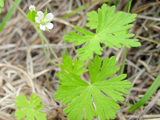Native Plants

Q. Who is Mr. Smarty Plants?
A: There are those who suspect Wildflower Center volunteers are the culpable and capable culprits. Yet, others think staff members play some, albeit small, role. You can torture us with your plant questions, but we will never reveal the Green Guru's secret identity.
Did you know you can access the Native Plant Information Network with your web-enabled smartphone?
Ask Mr. Smarty Plants is a free service provided by the staff and volunteers at the Lady Bird Johnson Wildflower Center.

rate this answer
Wednesday - January 16, 2008
From: Milford, CT
Region: Northeast
Topic: Wildflowers
Title: The most common wildflower in North America
Answered by: Nan Hampton and Joe Marcus
QUESTION:
Hi Mr. Smartyplants, What the most common wildflower in North America? My friend thinks it's the oxeye daisy. Is this correct? I work for a puzzle publishing company, and am doing research for a themed puzzle. The puzzle is about wildflowers. Hope you can help! Debra in Milford, CTANSWER:
The answer depends on how you define the terms, "common" and "wildflower." Many of the most "common wildflowers"—that is, species commonly called wildflowers and occurring in all 48 contiguous states—are of Old World origin. Many are also considered weeds. Among them are Oxeye daisy (Leucanthemum vulgare), Bull thistle (Cirsium vulgare), Bachelor's buttons (Centaurea cyanus), Queen Anne's-lace (Daucus carota), Henbit (Lamium amplexicaule), Dandelion (Taraxacum officinale) and Shepherd's purse (Capsella bursa-pastoris) that all came from Europe or Asia.
Native candidates that occur in all the "lower 48 states" (though all are not native to every state) are Common yarrow (Achillea millefolium), Carolina Crane's-bill (Geranium carolinianum), and Sleepy catchfly (Silene antirrhina).
For our money, however, the two most common wildflowers (herbaceous native plants with showy flowers) are Blackeyed Susan (Rudbeckia hirta) and Common sunflower (Helianthus annuus). Both occur all across America and in many places occur in vast numbers.
Good luck with your puzzle and we hope it includes lots of native wildflowers.
More Wildflowers Questions
New York City Native Perennials for a Long Growing Season
May 31, 2013 - Which native New York City perennials would be best for the longest growing season?
view the full question and answer
Native flowering plants for Frisco, Texas
August 12, 2015 - Hi There, I recently moved from Ohio, Cleveland to TX, Frisco. Could you please suggest me native flowering plants in my back yard and front yard. I like different flowers.
view the full question and answer
Lupines annual or perennial in Zone 4b from Austin
November 08, 2012 - Are lupines treated as perennials or annuals in Zone 4b (Northeast) if they are planted in the ground? Will other native species of lupines grow in a region they are not native to? Any recommendations...
view the full question and answer
How do I grow bluebonnets in East Texas?
April 03, 2009 - I live in the Piney Woods region in N.East Texas. I bought a flat of bluebonnets and want to know if they will grow back next year? If not, how do I get bluebonnets to grow back every year in my yard ...
view the full question and answer
Life cycle of Big Bend bluebonnet from Rosanky TX
April 29, 2010 - I have searched and searched and need to find the life cycle of a Big Bend Bluebonnet for a school project, but have been unable to find it. If there is a website that would have this information, ple...
view the full question and answer
| Support the Wildflower Center by Donating Online or Becoming a Member today. |

